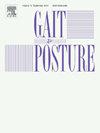Effects of age/gender profiles and physical activity level on symmetry of lumbar muscle activation in pain-free older adults during various spinal movements
IF 2.2
3区 医学
Q3 NEUROSCIENCES
引用次数: 0
Abstract
Background
Back muscles simultaneously drive spinal movements and stabilize the trunk. Paraspinal muscle activity is presumed to be symmetric and gender-insensitive, and more activated with aging to protect the spine during functional tasks.
Research question
Does over-activated and asymmetric behaviors exist in the pain-free elderly population which is affected by their physical activity levels?
Methods
Forty healthy participants (aged 64.8 ± 9.9 years, 20 males and 20 females) were recruited for this cross-sectional study. They completed the International Physical Activity Questionnaire (IPAQ) to quantify their self-reported physical activity measures including the total physical activity in MET-min/week and time spent sitting. Surface electromyographic activity of bilateral paraspinal muscles at L3 level was measured. Subjects were instructed to perform functional tasks including symmetric movements as well as right- and left-side rotation/bending. Asymmetry in muscle activation between the two sides was calculated. A multiple linear regression model was used to assess the association of muscle activations with age and gender. Pearson correlation analysis was used to verify the relationship between the asymmetry and physical activity measures.
Results and significance
The results showed a downtrend of paraspinal muscle activations with aging and the decreasing rate could differ between genders. Left-side muscle activations were generally higher than those of the right-side muscles. Muscle asymmetrical activation correlated with sitting time but not total physical activity. This study highlighted aging and gender effects on the paraspinal muscle activations as well as muscle imbalance during different movement paradigms. Future work is needed to verify the underlying mechanism for declining and asymmetrical muscle activation and its link to back disorders.
年龄/性别特征和体力活动水平对无痛老年人各种脊柱运动中腰肌激活对称性的影响。
背景:背部肌肉同时驱动脊柱运动和稳定躯干。棘旁肌的活动被认为是对称的和性别不敏感的,并且随着年龄的增长而更加活跃,以保护脊柱在功能性任务中。研究问题:无痛老年人是否存在过度激活和不对称行为,这与他们的身体活动水平有关?方法:本横断面研究招募40名健康受试者(年龄64.8 ± 9.9岁,男20名,女20名)。他们完成了国际体育活动问卷(IPAQ),以量化他们自我报告的体育活动措施,包括每周MET-min的总体育活动和坐着的时间。测量双侧L3水平棘旁肌的表面肌电活动。受试者被要求完成功能性任务,包括对称运动以及左右旋转/弯曲。计算了两侧肌肉激活的不对称性。使用多元线性回归模型来评估肌肉激活与年龄和性别的关联。使用Pearson相关分析验证不对称性与体力活动测量之间的关系。结果与意义:研究结果显示,随着年龄的增长,脊髓旁肌活动呈下降趋势,且下降幅度在性别间存在差异。左侧肌肉的激活程度普遍高于右侧肌肉。肌肉不对称激活与静坐时间相关,但与总体力活动无关。本研究强调了年龄和性别对不同运动模式下棘旁肌激活和肌肉失衡的影响。未来的工作需要验证肌肉激活下降和不对称的潜在机制及其与背部疾病的联系。
本文章由计算机程序翻译,如有差异,请以英文原文为准。
求助全文
约1分钟内获得全文
求助全文
来源期刊

Gait & posture
医学-神经科学
CiteScore
4.70
自引率
12.50%
发文量
616
审稿时长
6 months
期刊介绍:
Gait & Posture is a vehicle for the publication of up-to-date basic and clinical research on all aspects of locomotion and balance.
The topics covered include: Techniques for the measurement of gait and posture, and the standardization of results presentation; Studies of normal and pathological gait; Treatment of gait and postural abnormalities; Biomechanical and theoretical approaches to gait and posture; Mathematical models of joint and muscle mechanics; Neurological and musculoskeletal function in gait and posture; The evolution of upright posture and bipedal locomotion; Adaptations of carrying loads, walking on uneven surfaces, climbing stairs etc; spinal biomechanics only if they are directly related to gait and/or posture and are of general interest to our readers; The effect of aging and development on gait and posture; Psychological and cultural aspects of gait; Patient education.
 求助内容:
求助内容: 应助结果提醒方式:
应助结果提醒方式:


